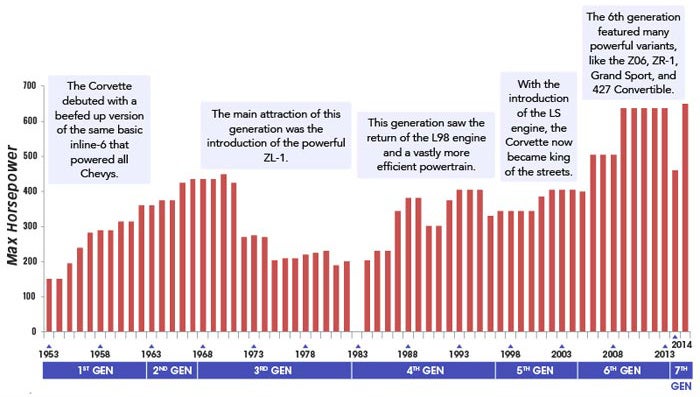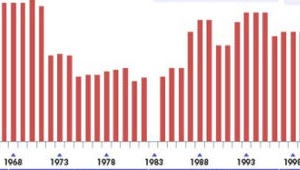 "StingrayJake" (stingrayjake)
"StingrayJake" (stingrayjake)
07/27/2015 at 17:40 ē Filed to: Corvette
 1
1
 8
8
 "StingrayJake" (stingrayjake)
"StingrayJake" (stingrayjake)
07/27/2015 at 17:40 ē Filed to: Corvette |  1 1
|  8 8 |

Sometimes I wonder what was going through Zora Arkus-Duntovís head when the EPA neutered the Corvette (and pretty much every other car) in the 1970s. It took almost two decades (arguably three) to recover.
Hereís a pretty cool little infographic from
!!!error: Indecipherable SUB-paragraph formatting!!!
showing the evolution of power in Americaís sports car. Itís too bad that the entire C3 generation is stuck with a horrible stigma. It was a fantastic design. Iíll say this, though, the last decade has been a fun time to be a Corvette lover.
You can view the rest of the infographic at
!!!error: Indecipherable SUB-paragraph formatting!!!
.
 lone_liberal
> StingrayJake
lone_liberal
> StingrayJake
07/27/2015 at 17:48 |
|
Sucked more for people in California and anywhere else that did emission inspections. Everybody else just took all of that crap off and threw it away. Thatís why itís so hard for the guys doing full restorations to find things like original smog pumps. You couldnít get 1970 levels of power but without cats, smog pumps, EGR valves, etc. and with a good tune, carb, headers and cam you could at least make them driveable.
 AMC/Renauledge
> StingrayJake
AMC/Renauledge
> StingrayJake
07/27/2015 at 17:48 |
|
You canít really compare power figures of pre-1972 cars with gross hp and post-1972 cars with SAE net.
And if you did, I am sure that any 1970s or 80s Corvette would trounce any C1.
 LongbowMkII
> StingrayJake
LongbowMkII
> StingrayJake
07/27/2015 at 17:51 |
|
Eh, without the emissions standards I donít think the industry would have spent so much time and money making engines run as fast and efficient. They would have just picked fast and cheap (not that there's any problem with that on a personal level)
 StingrayJake
> LongbowMkII
StingrayJake
> LongbowMkII
07/27/2015 at 17:59 |
|
Thatís the other side of all this. Truth is regulations helped spur technology. Itís like in racing. A governing body deems cars too fast so they make a rule. Over the next few years engineers concoct ways to be fast again while following the rule. Regulations can breed improvement, it just took the Corvette a few years.
 PS9
> StingrayJake
PS9
> StingrayJake
07/27/2015 at 20:16 |
|

Teacher: And here, we can see the bottomless gulch of Malaise Valley.
Timmy: Zero Horsepowders? But...but...how did people move their cars around back then?
Teacher: Just...*
sniff*...
just know that it was a dark time Timmy. Many sacrificed to give us the glorious 30MPG 300HP future we live in today. Remember them, and be glad you werenít born in that terrible era. Rest In Peace my lovely Annabelle...
 samssun
> StingrayJake
samssun
> StingrayJake
07/27/2015 at 21:15 |
|
Regulations mostly push your effort/expense from innovation to workarounds and loopholes. Instead of trying to do a better job than the next guy, you try to get around what heís handicapped with, just like megacorps who welcome more compliance laws because they can afford the waste while little guys get buried.
Figuring out ways to hide your suspension or aero adjustments, or route extra air around an artificially limited opening, might let you outrun equally-hobbled competitors, but thatís still a dead weight loss of effort and resources that couldíve gone into real innovation.
 Axial
> AMC/Renauledge
Axial
> AMC/Renauledge
07/27/2015 at 22:06 |
|
It takes a 427 or bigger for any C3 or older to actually beat a 1984 C4 in a straight line, and the C4 in general will brutalize anything before it in the corners.
 orcim
> samssun
orcim
> samssun
07/28/2015 at 04:47 |
|
I think youíve got some it right in your comment, and I agree that does in fact happen, but I donít see it as the whole picture for problem solving.
Maybe Iím reading some of my own tech background into this, too, and not paying as much attention to the automotive scene which you are specifically commenting on. Iíve been on teams that could do anything, and they were the worst for shipping a product, while the teams working under accepted constraints (not random ones from outer space) usually ended up being pretty clever and latched at what could be done within the constraints. Just my perceptions, tho.